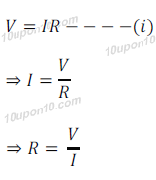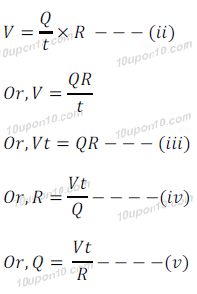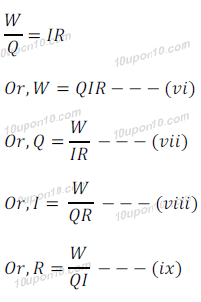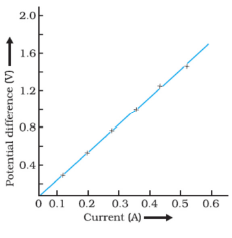Electricity - Class 10th Science
Ohm's Law
George Simon Ohm, a German Physicist and Mathematician found a typical relationship between potential difference (V) and electric current (I). This relationship is known as Ohm's Law.
Ohm's Law states that potential difference across the given conductor is directly proportional to the electric current flowing through it at constant temperature.
Let the electric current 'I' is drawn through an electric circuit and potential difference between two ends of the electric circuit is equal to 'V'.
Therefore, according to Ohm's Law V ∝ I
Or, V = IR -------- (i)
Where, I = electric current
V = potential difference between two ends of the electric circuit.
R = constant.
Constant R is known as Resistance of conductor.
Expression (i) is known as the Expression for Ohm's Law.
According to Ohm's Law, electric current increases with increase in potential difference and decreases with decrease in potential difference.
Thus, knowing any two among V(potential difference), I (Electric current) and R(resistance), third one can be calculated.
Different forms of the expression of Ohm's Law

Explanation of Ohm's Law
(a) Electric current increases with increase in potential difference.
(b) Electric current decreases with decrease in potential difference.
(c) At constant potential difference with decrease in electric current, resistance (R) increases and vice versa.
(d) At constant electric current, with increase in potential difference (V), resistance (R) increases and vice versa.
We know that electric current 'I' = Q/t
Thus, after replacing 'I' with Q/t in the Ohm's Law expression, we get

Now, we know that Potential difference V = W/Q
Thus, by substituting V = W/Q in equation (ii), we get

By knowing any three among four, i.e. R, W, Q and I, fourth can be calculated using equation (vi), (vii), (viii) or (ix).
Graph of Potential difference (V) vrs electric current (I)
When a graph of potential difference (V) versus electric current (I) is plotted it always be a straight line passing through the origin.

Ref: Figure taken from NCERT book
This happens because the ratio of potential difference (V) and electric current (I) is constant.